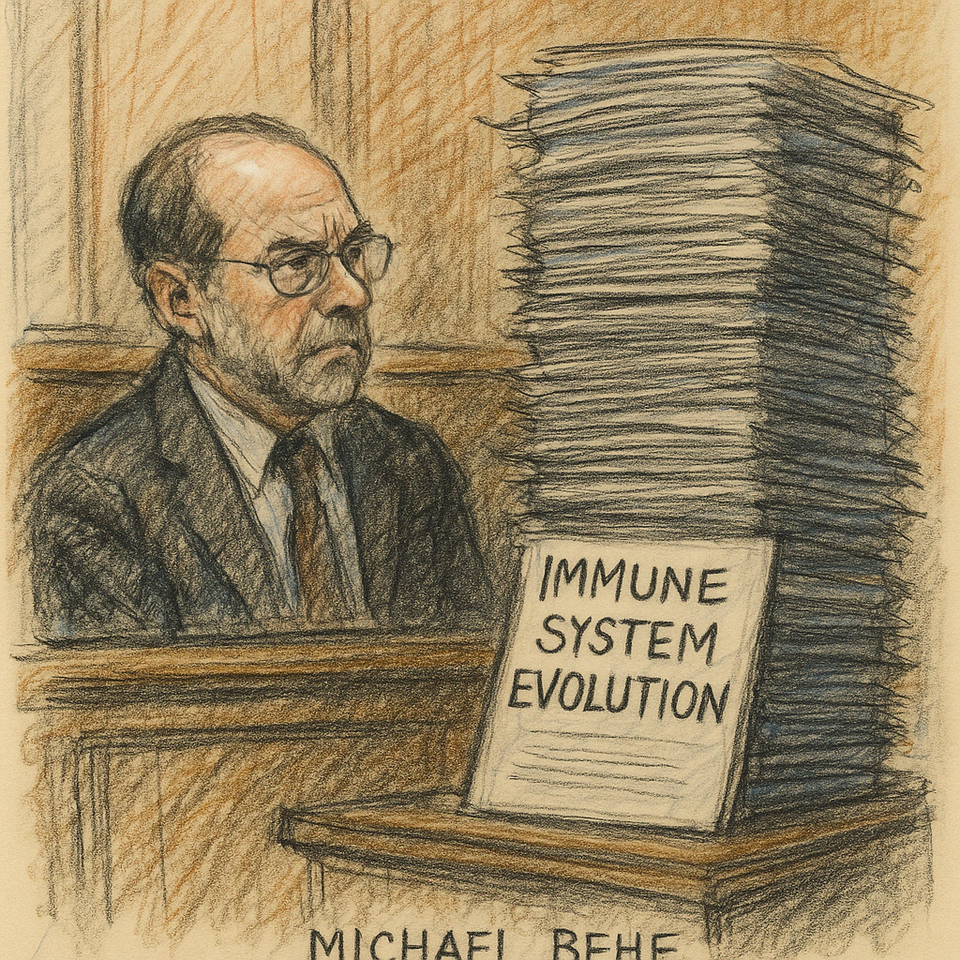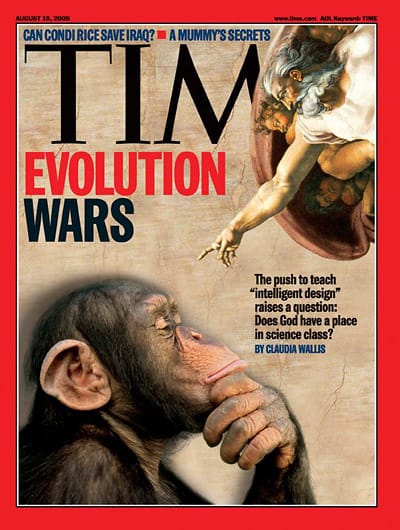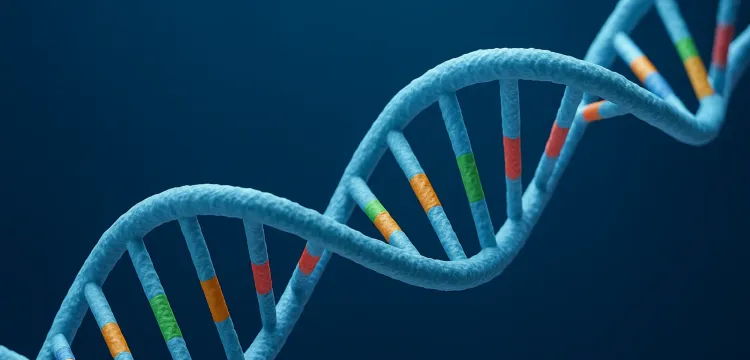Kitzmiller v. Dover, Part One: Michael Behe, Intelligent Design, and the Tower of Denial

TL;DR: The Dover trial wasn’t just a legal showdown—it was a public dissection of intelligent design’s scientific credibility. In this first essay, we dive into how the ID movement tried to pass itself off as science in court, only to be undone by its star witness and a stack of books he insisted didn’t exist.
The Legal Strategy: Repackaging Religion for the Science Classroom
By 2004, the Dover Area School District in Pennsylvania had decided to walk a well-worn path: challenging the dominance of evolution in public education. The school board required teachers to present intelligent design (ID) as an alternative to Darwinian evolution and directed students to the book Of Pandas and People—a now-infamous pseudoscientific tract.
This was not a bold new idea. The U.S. Supreme Court had already ruled in Edwards v. Aguillard (1987) that teaching creationism in public schools violated the Establishment Clause. But intelligent design, its proponents insisted, was different. They claimed it was not religious, not creationist, and certainly not theological. It was, they said, science.
So the Kitzmiller trial became a test case: could ID survive scrutiny as a scientific theory, or would it collapse under cross-examination? The courtroom would decide whether this “theory” had any legitimate standing in biology—or whether it was simply creationism with better marketing.

Michael Behe: The Star Witness for a Sinking Ship
Michael Behe, a biochemist at Lehigh University and leading ID advocate, took the stand as the defense’s star witness. A practicing scientist with an academic pedigree, Behe was the ID movement’s best chance to prove its credibility. He had coined the concept of “irreducible complexity,” arguing that biological systems like the bacterial flagellum or the immune system couldn’t evolve step by step because they’d stop working if even one part were missing.
On paper, Behe looked formidable. He spoke with the calm precision of someone used to lecturing undergrads and debating critics. But as the cross-examination began, it quickly became clear that rhetoric and credentials alone wouldn’t be enough to carry the day.
Attorney Eric Rothschild of the ACLU methodically dismantled Behe’s claims. When Behe insisted that there were no peer-reviewed studies explaining the evolutionary development of the immune system—specifically mechanisms like the blood-clotting cascade or the body's response to infection—Rothschild responded with an avalanche.
He began stacking book after book and study after study onto the witness stand—nearly fifty in total. Each one provided research into the evolution of immune system complexity, directly contradicting Behe’s claim.
The moment was cinematic. A tower of published science stood beside a man who insisted it didn’t exist.
Behe, astonishingly, stood by his assertion. He dismissed the entire stack by claiming none of it “satisfactorily” addressed the question. To an outside observer, this wasn’t rigorous skepticism—it was denial in real-time. It was a deeply human moment too: a man so convinced of his paradigm that even a mountain of evidence couldn’t move him. And it underscored what critics had long argued—ID wasn’t a genuine research program. It was a belief system cloaked in the language of science.
Later, in his ruling, Judge Jones remarked, “In fact, on cross-examination, Professor Behe was questioned concerning his 1996 claim that science would never find an evolutionary explanation for the immune system. He was presented with fifty-eight peer-reviewed publications, nine books, and several immunology textbook chapters about the evolution of the immune system; however, he simply insisted that this was still not sufficient evidence of evolution, and that it was not ‘good enough.’” (Jones 89)

Kitzmiller v. Dover, Part Two: Pandas, Proponentsists, and the Find-and-Replace Fail Heard ’Round the Courtroom
Redefining ‘Science’ Until It Includes Astrology
Behe’s most revealing moment came when he was asked to define “scientific theory.” Under questioning, he described it as “a proposed explanation which focuses or points to physical, observable data and logical inferences.” But under that definition, Rothschild pressed, wouldn’t astrology qualify as science?
Behe’s answer: yes.
It wasn’t a trick. It wasn’t a misstep. It was an honest admission—and a telling one.
Judge John E. Jones III captured the absurdity in his written opinion:
“Under Behe’s definition, ID is a scientific theory, but so is astrology. While we take no position on the veracity of either view, this comparison highlights the definition’s scope—it is so broad that it would allow anything to qualify as science. It renders the concept virtually meaningless.” (Jones 71)
For Behe, it may have felt like a principled stand—an effort to widen the tent of scientific discourse. But for the court, it exposed the intellectual incoherence at the heart of the ID movement. If everything is science, then nothing is.
• Creation “Science” and the Gospel According to AiG
• The Giraffe’s Ridiculous Nerve: A Case for Evolution
• How the Eye Evolved (Yes, It DID Evolve)
What This Testimony Meant for the Case
Behe’s refusal to accept mainstream research, his broad and unworkable definition of science, and his reliance on rhetorical rather than evidential claims all led Judge Jones to a stark conclusion: intelligent design isn’t science.
More than that, Behe’s performance exposed the weakness at the heart of the ID movement. It claimed to be open to evidence, but its leading advocate dismissed mountains of it out of hand. It claimed to be scientific, but its own witnesses couldn’t agree on what “science” meant.
It was, in the end, a human story—a story of belief held so tightly that it cracked under pressure.
Next time: We’ll look at the book that sparked it all—Of Pandas and People—and how a careless find-and-replace turned creationism into “cdesign proponentsism,” the most revealing typo in legal history.
Works Cited
Behe, Michael. Darwin’s Black Box: The Biochemical Challenge to Evolution. Free Press, 1996.
Humes, Edward. Monkey Girl: Evolution, Education, Religion, and the Battle for America's Soul. Ecco, 2007.
Jones, John E. III. Kitzmiller v. Dover Area School District. 400 F. Supp. 2d 707 (M.D. Pa. 2005).
National Center for Science Education. Kitzmiller v. Dover Trial Transcript. https://ncse.ngo.
Pennock, Robert T. Tower of Babel: The Evidence Against the New Creationism. MIT Press, 1999.
PBS NOVA: Judgment Day – Intelligent Design on Trial
Ken Miller explains the human–chimp chromosome fusion
Works Cited
Jones, John E. III. Kitzmiller v. Dover Area School District. 400 F. Supp. 2d 707 (M.D. Pa. 2005).
Humes, Edward. Monkey Girl: Evolution, Education, Religion, and the Battle for America's Soul. Ecco, 2007.
Behe, Michael. Darwin’s Black Box: The Biochemical Challenge to Evolution. Free Press, 1996.
National Center for Science Education. Kitzmiller v. Dover Trial Transcript. https://ncse.ngo.
Pennock, Robert T. Tower of Babel: The Evidence Against the New Creationism. MIT Press, 1999.





Comments ()